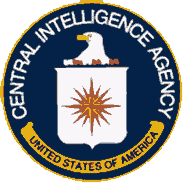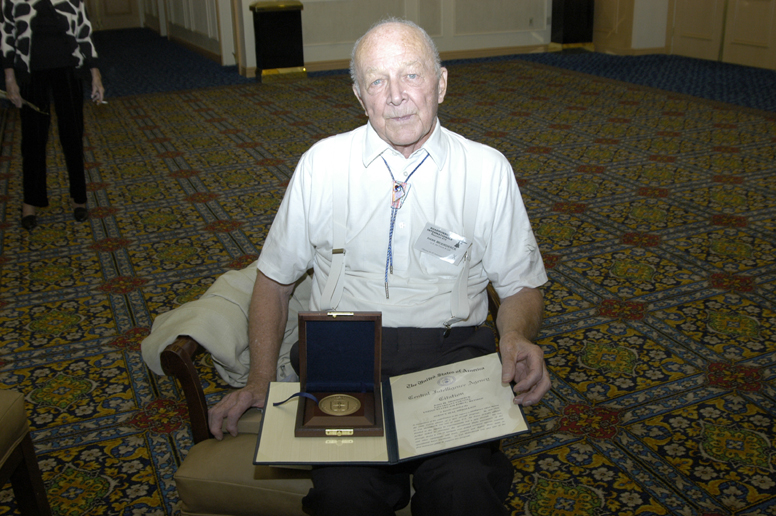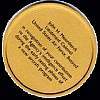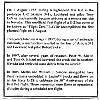


 |
 |
 |

 |
 |
 |
 |
 |

Meierdierck CIA award and the Merlin award awarded at Roadrunners Internationale Groom Lake 50th anniversary - October 6, 2005
 |
 |
 |
 |
 |
 |
BIOGRAPHY
John Henry "Hank" Meierdierck was born in Newark, New Jersey in 1921. His parents spent 11 years in the area living in near poverty. At age eleven, Hank's family moved to Chestertown in upstate New York. Still poor, the family grew a garden for vegetables and ran a trap line for game. Their diet consisted of the vegetables they grew, venison, and an occasional chicken. Hank rode a bus to school nine miles away.
Tragedy struck when he was 12 when the house caught on fire. He, his father and 3 brothers escaped out the second story window into the snow. The family moved back to Newark and further poverty. Hank worked delivering papers and in several grocery stores during his high school years. He never had a chance to attend college until much later. At age 42 he received a degree from the University of Maryland.
Hank worked in a shipyard as an accountant and as a mail runner to New York. With the outbreak of World War II, Hank signed up for cadets and was commissioned a Second Lieutenant "fighter pilot" in July 1943. He was assigned to various bases flying P-39, P-40, P-47, etc. and went to France in 1944 where he flew a F-6d and a camera-mounted P-51D. He flew 13 tactical reconnaissance missions over Germany during WWII.
Returning to the United States, in 1945 Hank flew his first jet, a P-80 in the 4th Fighter Group at Andrews Field. Assigned to Panama, he flew reconnaissance missions in a RF-80. Caught up in the post WWII RIF, he enlisted as a Master Sergeant and transferred to March AFB in California. Three months later he was recalled as a First Lieutenant for pilot duty.
Hank spent several years in the 31st and 508th fighter wings in Albany, Georgia. Later on he performed tests on the F-84G at Edwards AFB where he pioneered air to air refueling the F-80 and F-84 fighters using the probe and drogue system. He performed mission planning and flew the F-84G over the North Atlantic, Central Atlantic, and the Pacific oceans. From duties as Air Force program manager for celestial navigation for fighters, in June 1954 he received orders to report to March AFB where he commenced his U-2 experience at Area 51.
At the Area, Hank's duties were to integrate the U-2 test phase with LAC pilots, determine the tactical use of the aircraft, and train three detachments of pilots for the Central Intelligence Agency. Upon completion of this assignment, Hank spent some time in the UK and ended up serving as Director of Operation for the 414th Fighter Group flying F-101B interceptors at Oxnard AFB, California. Three years later he was visiting the Pentagon and found he was being considered for another "black" assignment. The assignment turned out to be with the Central Intelligence Agency headquarters as Director of Operations for the OXCART program at Area 51. Hank flew the YF-12A once while at the Area. When the OXCART program ended, he remained with the OSA for another program assignment as Program manager and unit commander of the 4027th Squadron at Area 51. He and Millie moved to Las Vegas.
Hank's second tour at the Area was as Commander and program Director for Project Aquiline. At Hank's suggestion, this program was aborted. Hank retired in Las Vegas and spent many years fishing and trailering to Canada, Mexico, and wherever the Bass or game fish were plentiful. He is still going strong at age 84 in 2005.
More about Hank's life and career can be obtained from his book.
 Click to view Video |

Roadrunners Internationale members around the world are mourning the loss today of one of their past presidents. Lt. Col. Meierdierck (84) was an aviation icon within both the Air Force and CIA communities.
 John Henry "Hank" Meierdierck was born in Newark, New Jersey in 1921. With the outbreak of World War II, Hank signed up for cadets and was commissioned a Second Lieutenant "fighter pilot" in July 1943. He was assigned to various bases flying P-39, P-40, P-47, etc. and went to France in 1944 where he flew a F-6d and a camera-mounted P-51D. He flew 13 tactical reconnaissance missions over Germany during WWII.
John Henry "Hank" Meierdierck was born in Newark, New Jersey in 1921. With the outbreak of World War II, Hank signed up for cadets and was commissioned a Second Lieutenant "fighter pilot" in July 1943. He was assigned to various bases flying P-39, P-40, P-47, etc. and went to France in 1944 where he flew a F-6d and a camera-mounted P-51D. He flew 13 tactical reconnaissance missions over Germany during WWII.
Returning to the United States, in 1945 Hank flew his first jet, a P-80 in the 4th Fighter Group at Andrews Field. Assigned to Panama, he flew reconnaissance missions in a RF-80. Caught up in the post WWII RIF, he enlisted as a Master Sergeant and transferred to March AFB in California. Three months later he was recalled as a First Lieutenant for pilot duty.
Hank spent several years in the 31st and 508th Fighter Wings in Albany, Georgia. Later on he performed tests on the F-84G at Edwards AFB where he pioneered air to air refueling the F-80 and F-84 fighters using the probe and drogue system. He performed mission planning and flew the F-84G over the North Atlantic, Central Atlantic, and the Pacific oceans. From duties as Air Force program manager for celestial navigation for fighters, in June 1954 he received orders to report to March AFB where he commenced his U-2 experience at Area 51.
At the Area, Hank's duties were to integrate the U-2 test phase with LAC pilots, determine the tactical use of the aircraft, and train three detachments of pilots for the Central Intelligence Agency. Upon completion of this assignment, Hank spent some time in the UK and ended up serving as Director of Operation for the 414th Fighter Group flying F-101B interceptors at Oxnard AFB, California. Three years later he was visiting the Pentagon and found he was being considered for another "black" assignment. The assignment turned out to be with the Central Intelligence Agency headquarters as Director of Operations for the OXCART program at Area 51. His CIA code-name was Rufus. Hank flew the YF-12A once while at the Area. When the OXCART program ended, he remained with the OSA for another program assignment as Program manager and unit commander of the 4027th Squadron at Area 51. He and Millie moved to Las Vegas.
Hank's second tour at the Area was as Commander and program Director for Project Aquiline. At Hank's suggestion, this program was aborted. Hank retired in Las Vegas and spent many years fishing and trailering to Canada, Mexico, and wherever the Bass or game fish were pl
Hank is survived by his wife, Millie of Las Vegas, NV; daughter Gail Meierdierck and husband Manny Rameriz, Redding, CA; son Jay Meierdierck and wife Janet of Carson City, NV; daughter Victoria Welch, 5 grand children, and 8 great grand children.
Funeral services will be at 1120 hours, March 24 at the Southern Nevada Veterans Memorial Cemetery, Boulder City, Nevada. In lieu of flowers, the family suggests that any memorial donations be made in Hank's name to the Nellis Support Team at 911 N. Buffalo Drive #201, Las Vegas, NV 89128.
Those in the Roadrunner organization are happy to know that Hank's departure on his final flight was launched from Cloud Nine. At the Roadrunner reunion last October Hank received an award from the CIA in recognition of his contribution to the early CIA U-2 program at Area 51. Additionally, Hank was subsequently recognized in various ceremonies recognizing the 50th anniversary of the arrival of the U-2 Dragonlady spyplane at Area 51.
October 19, 2014: The Roadrunner staff regrets having to inform you that Millie Meierdierck took her final flight this past weekend to join former Roadrunner president Lt. Col. Hank Meierdierck, former IP for the three CIA U-2 detachments at Area 51 in the 1950s, and CIA operations officer for A-12 Project OXCART at Area 51 in the 1960s. There will be no services as the family held a huge reunion this summer that she fully participated in. We will miss you Millie.
 |
 |
 |